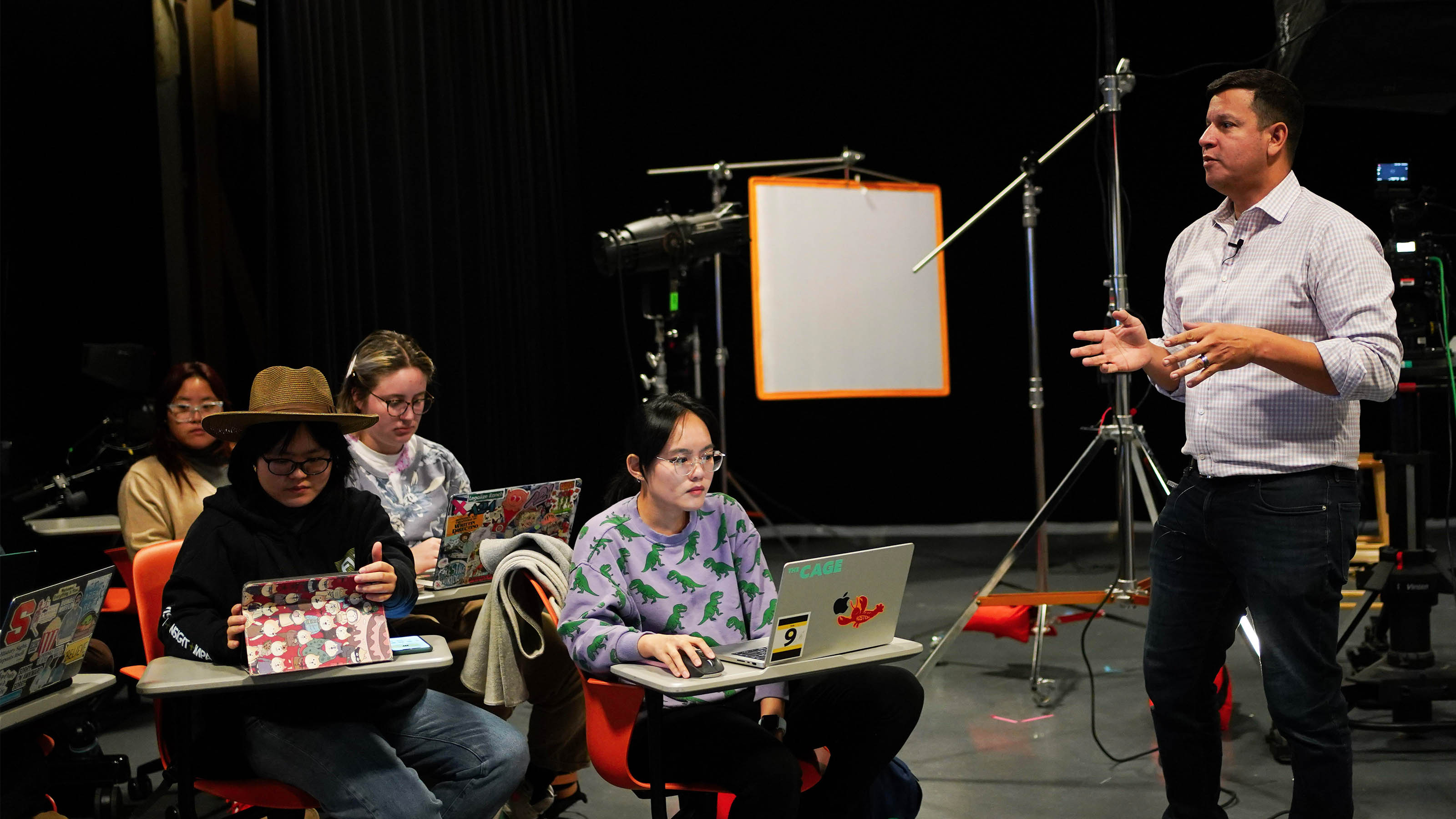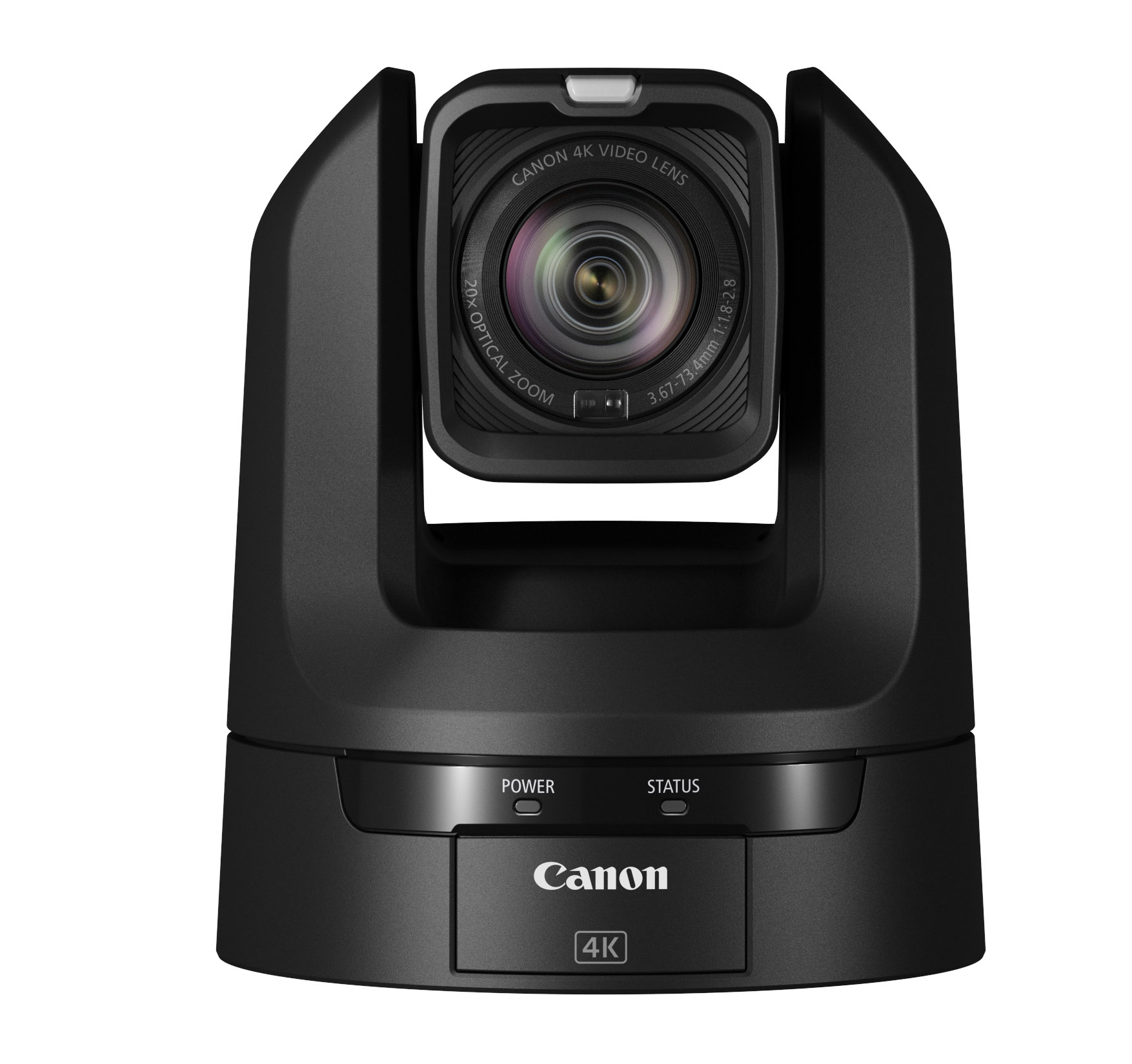
Milton Santiago, assistant professor of visual communications at Syracuse University’s Newhouse School of Public Communications, is using Canon’s innovative Activate My Line of Sight (AMLOS) technology to bring an all-new hybrid experience to in-class and remote students. Since Santiago put the software to use in Fall 2022, he has continued to find new ways to use AMLOS to better engage his students across the globe.

And so does Canon. Since showcasing the AMLOS software at the 2022 NAB Show, Canon's Thomas Cusanelli, senior specialist, product marketing, and Kohei Maeda, advisor, new business development, have worked closely with Santiago to enhance both the student experience and Canon’s software.
As with many innovations currently in the hybrid world, AMLOS was born during the pandemic. The concept was a new way to visualize the workplace and bring new software to Canon’s already renowned hardware portfolio. What originated as a concept in Summer 2020 quickly evolved, as Canon looked ahead to what the hybrid world—a term still yet undefined in 2020—would look like, especially in instances like creative brainstorming sessions when people couldn’t be together.
“We thought a hybrid brainstorm session is an area we can help improve,” Maeda explained of AMLOS’ early beginnings. “We utilized a 4K PTZ camera not originally meant for the meeting room—it is the live streaming standard, more for house of worship or sporting events, with 4K pan-tilt-zoom features. We leveraged these features to meeting spaces and then developed the software to support the creative equivalent. And that's how we started.”
An Ongoing Conversation
With AMLOS, a single Canon PTZ camera creates multiple video streams, allowing all participants to not only see what’s happening, but interact with the customizable user interface to see various live streams, screen captures, and even whiteboards. Any remote user can have different boxes on their screen side by side.
From inside the AMLOS room, hand gestures signal the camera to highlight an object or an area in the room while providing a 4K capture of the area. In Santiago’s case, for his lighting and lensing class, it allows him to show students a close-up view of a camera while writing notes on a whiteboard about that camera—with the freedom to move around the classroom space while students follow the conversation.
Canon's initial NAB experimental showcase positioned AMLOS for meeting spaces. But when Maeda and Cusanelli met Santiago, it sparked a conversation that lasted several months, focused on the possibilities of AMLOS in the classroom.
[How a Syracuse Auditorium Transforms from Lecture Hall to Debate Stage]
Milton had so many different ideas on how to use it with different projects at Syracuse, in classrooms, different workshops," Cusanelli recalled, "and we were just really excited to think about all the different ways that we could see AMLOS being used in this type of educational setting. I think a light bulb went off for all of us, and we wound up bringing our first set of AMLOS to Syracuse.”

The light bulb was just the start. Cusanelli and Maeda attended one of Santiago’s classes and observed what worked and didn’t work. Santiago would present new ideas to the AMLOS team—and they listened. For example, the AMLOS team enhanced the software, once solely designed for a PTZ camera, to allow for a feed from a Canon cinema camera to also be part of the presentation.
[NAB: Broadcast Quality for the Next Generation]
“I feel like that really gave us a lot to work with, and now we're exploring how we can add on top of that, too, like bringing in video feeds from other devices like mixed-reality goggles or headsets,” Cusanelli said. “It's working together and bouncing those ideas off each other that really gave us a lot of opportunity to just enhance AMLOS in all different kinds of ways.”
“It's very rare that we get an opportunity to deal directly with a vendor or a software programmer and have modifications made and be able to pitch ideas,” Santiago said. “I think what has been awesome about this collaboration is that the AMLOS team has listened to what it is I'm trying to get accomplished and what I value as the core learning objectives. And we've had very productive back and forth that's served as a springboard for something new.”
Back to School
Canon cameras—like the EOS R5 C hybrid camera, EOS C300 Mark II, and EOS C70 digital cinema cameras for filmmaking—were already being used on the Syracuse campus at Newhouse as well as the Visual Performing Arts School, so AMLOS seemed like a natural progression.
“It was very important to me to get our equipment in the hands of the students who are going to be the next professionals in visual communications and journalism and broadcast and film,” explained Lisa Gualtieri Alford, vertical sales manager, education and B2B for Canon, who worked on the hardware side bringing the cameras required for Santiago’s vision into the equation. “Because whatever you use in school and you become familiar with, that tends to be what you end up buying when you become a professional.”
The decision was made to not permanently install AMLOS into one Newhouse classroom, but to give Santiago the mobility needed to move to different environments. They created a mobile TV cart, which includes a Canon CR-N300 4K PTZ camera on top, a box PC that houses the AMLOS software on a shelf, and a display. A teacher simply plugs it in and the AMLOS solution is ready to go. After designing and presenting the cart, Maeda said that the mobile solution is catching on with other customer sites, providing yet another instance when the Canon team and Santiago helped each other.
“It's working together and bouncing those ideas off each other that really gave us a lot of opportunity to just enhance AMLOS in all different kinds of ways.”
Thomas Cusanelli, Canon
Teaching cinematography is not the same as teaching history. Students need to understand the mechanisms and editing process. Santiago is using AMLOS in a variety of ways to do just that at Newhouse, and envisions bringing his lessons not only to the upstate New York campus, but to multiple campuses across the country, cities like Los Angeles or New York, or even students studying abroad. In fact, he intends to deploy AMLOS for a creative collaboration between students at the Newhouse School and the Ferré Rangel School of Communication at the Universidad del Sagrado Corazón (Puerto Rico) this fall.
“[Santiago’s classes] are really innovative with this technology to be able to use it in a different way than just having a meeting and seeing each other,” said Gualtieri Alford. “They can actually see what they're working on, and it's not just sharing a screen. It's interactive and collaborative in real time in a way that solutions a lot of other schools are using don’t provide.”
[Watch: Canon PTZs Ride the Waves...for Pepperdine Athletics Productions]
Santiago appreciates the multiple views AMLOS brings to his lessons. Take, for example, showcasing a camera or light in class. Sure, the in-person student can hold it and examine it, but Santiago finds that AMLOS brings a new dimension to remote students.
“They may or may not be able to see that from their seats in the classroom,” he said. “But by being able to spotlight the internal mechanism, now the students, regardless of whether or not they're physically holding the light or watching from their laptops, they're getting another view of that device, which, again, it just accelerates the potential for me as an instructor to make those connections faster.”
Outside-the-Box Innovation
While using the solution presented a learning curve for students, there was something else Santiago had to master: the hand gestures. “The hand gesture, at first, did not come natural to me,” Santiago said, laughing. “It was a little bit of a learning process for me to think about my gesticulation and how that might impact the lesson flow.”
Naturally, Canon listened. “What they were kind enough to do,” Santiago continued, “is to make a modification where I could have a clicker remote. I would get in the general area of what I wanted to highlight, and I would hit this clicker.”
The "clicker" enhancement is also forward thinking in an age where accessibility is so important to every technological design. Thanks to Santiago’s learning curve, AMLOS now has options for those who may not be able to hand gesture.
Sometimes, being in the right place at the right time happens to work out. Santiago’s visit to Canon's NAB booth has certainly shown that to be true. The collaboration continues—and with how responsive Canon is to Santiago’s feedback, it seems like they are just scratching the surface on what AMLOS can do in higher education classrooms.
“AMLOS has unlocked new levels of interactivity in the classroom and new ways for me to make connections for students in terms of their analysis of images, lensing, and lighting at a much faster pace,” Santiago explained. “I've spent some time researching why this seems to work. And there's a lot out there about the value of presenting information side by side. There's a lot out there about cognitive load and how much information we can process before it starts to be overwhelming. There's a lot of research around interactivity and how giving students agency over how they're processing the information will allow them to really retain it.
"So, we have started exploring all the possibilities of how, at least within my particular discipline of cinematography, how giving students the ability to the manipulate images and information in real time without being dependent on the instructor, how that changes the dynamic of their learning experience.”
Along with speaking at CES 2023, Santiago recently presented his AMLOS experience at a Syracuse symposium. It is there that fellow professors and educators saw what AMLOS provides: endless possibilities to connecting with students anywhere.
“It's a way to think out of the box, to really allow people who are in different parts of the country or the world to work together in real time on projects, especially for schools that have campuses in different locations,” added Gualtieri Alford. “A school might have a campus in New York, but then they might also have a campus in LA or Paris or Dubai or China. And I think that is something that is really important, because as we proceed living in this global world, in a global economy and global stories, it allows people to work together to have the ability to create those stories and to be able to disseminate them globally.”







